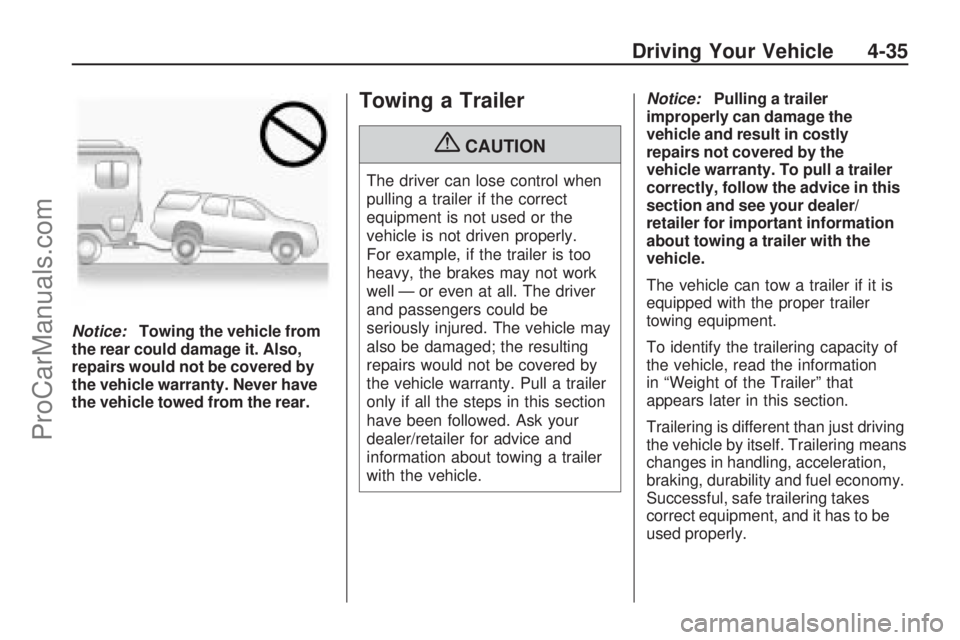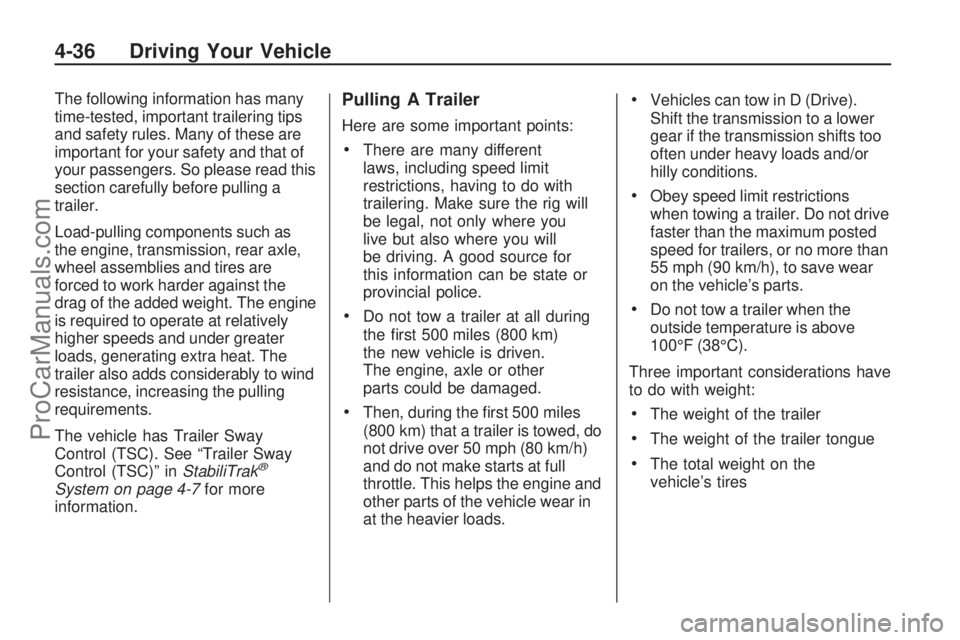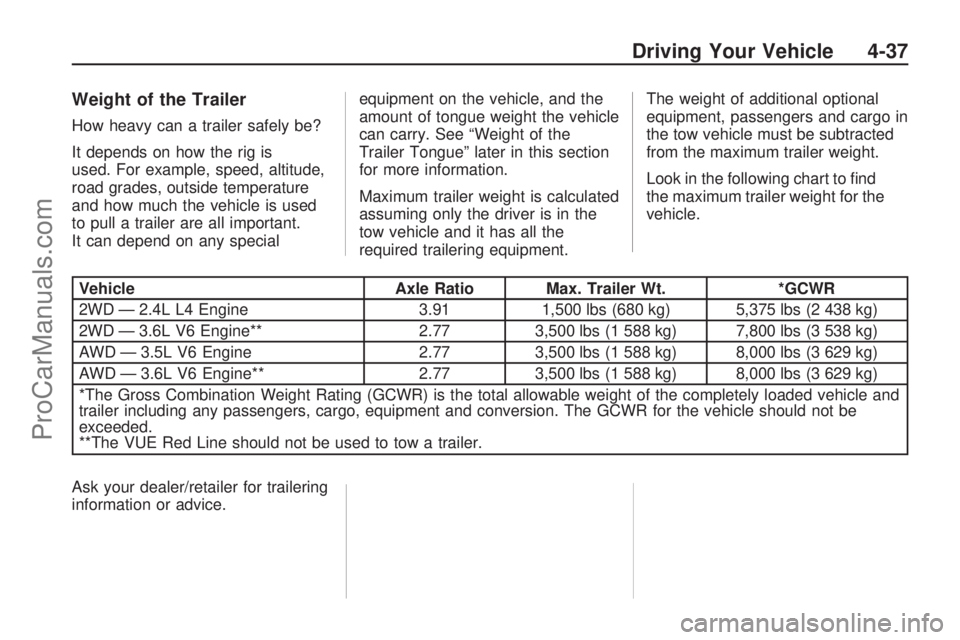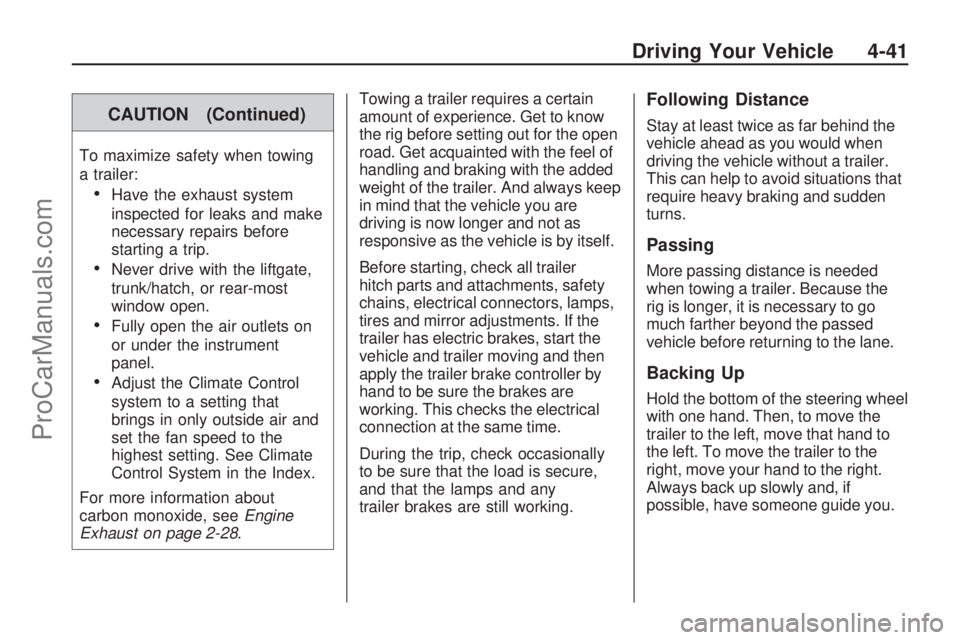weight SATURN VUE 2009 User Guide
[x] Cancel search | Manufacturer: SATURN, Model Year: 2009, Model line: VUE, Model: SATURN VUE 2009Pages: 386, PDF Size: 2.3 MB
Page 235 of 386

The label shows the gross
weight capacity of your vehicle.
This is called the Gross
Vehicle Weight Rating (GVWR).
The GVWR includes the
weight of the vehicle, all
occupants, fuel, cargo, and
trailer tongue weight, if
the vehicle is pulling a trailer.
The Certi�cation/Tire label also
tells you the maximum weights
for the front and rear axles, called
the Gross Axle Weight Rating
(GAWR). To �nd out the actual
loads on your front and rear
axles, you need to go to a weigh
station and weigh your vehicle.
Your dealer/retailer can help you
with this. Be sure to spread out
your load equally on both sides of
the centerline.
Never exceed the GVWR for
your vehicle or the GAWR
for either the front or rear axle.{CAUTION
Do not load the vehicle any
heavier than the Gross Vehicle
Weight Rating (GVWR), or
either the maximum front or
rear Gross Axle Weight Rating
(GAWR). If you do, parts on
the vehicle can break, and it
can change the way your
vehicle handles. These could
cause you to lose control and
crash. Also, overloading can
shorten the life of the vehicle.
Notice
:Overloading your
vehicle may cause damage.
Repairs would not be covered
by your warranty. Do not
overload your vehicle.
If you put things inside your
vehicle — like suitcases, tools,
packages, or anything else, they
will go as fast as the vehicle
goes. If you have to stop or turn
quickly, or if there is a crash,
they will keep going.
{CAUTION
Things you put inside your
vehicle can strike and injure
people in a sudden stop or
turn, or in a crash.
Put things in the cargo
area of your vehicle. Try to
spread the weight evenly.
Never stack heavier
things, like suitcases,
inside the vehicle so that
some of them are above
the tops of the seats.
Do not leave an unsecured
child restraint in your
vehicle.
When you carry something
inside the vehicle, secure it
whenever you can.
Do not leave a seat folded
down unless you need to.
Driving Your Vehicle 4-31
ProCarManuals.com
Page 239 of 386

Notice:Towing the vehicle from
the rear could damage it. Also,
repairs would not be covered by
the vehicle warranty. Never have
the vehicle towed from the rear.
Towing a Trailer
{CAUTION
The driver can lose control when
pulling a trailer if the correct
equipment is not used or the
vehicle is not driven properly.
For example, if the trailer is too
heavy, the brakes may not work
well — or even at all. The driver
and passengers could be
seriously injured. The vehicle may
also be damaged; the resulting
repairs would not be covered by
the vehicle warranty. Pull a trailer
only if all the steps in this section
have been followed. Ask your
dealer/retailer for advice and
information about towing a trailer
with the vehicle.Notice:Pulling a trailer
improperly can damage the
vehicle and result in costly
repairs not covered by the
vehicle warranty. To pull a trailer
correctly, follow the advice in this
section and see your dealer/
retailer for important information
about towing a trailer with the
vehicle.
The vehicle can tow a trailer if it is
equipped with the proper trailer
towing equipment.
To identify the trailering capacity of
the vehicle, read the information
in “Weight of the Trailer” that
appears later in this section.
Trailering is different than just driving
the vehicle by itself. Trailering means
changes in handling, acceleration,
braking, durability and fuel economy.
Successful, safe trailering takes
correct equipment, and it has to be
used properly.
Driving Your Vehicle 4-35
ProCarManuals.com
Page 240 of 386

The following information has many
time-tested, important trailering tips
and safety rules. Many of these are
important for your safety and that of
your passengers. So please read this
section carefully before pulling a
trailer.
Load-pulling components such as
the engine, transmission, rear axle,
wheel assemblies and tires are
forced to work harder against the
drag of the added weight. The engine
is required to operate at relatively
higher speeds and under greater
loads, generating extra heat. The
trailer also adds considerably to wind
resistance, increasing the pulling
requirements.
The vehicle has Trailer Sway
Control (TSC). See “Trailer Sway
Control (TSC)” inStabiliTrak
®
System on page 4-7for more
information.
Pulling A Trailer
Here are some important points:
There are many different
laws, including speed limit
restrictions, having to do with
trailering. Make sure the rig will
be legal, not only where you
live but also where you will
be driving. A good source for
this information can be state or
provincial police.
Do not tow a trailer at all during
the �rst 500 miles (800 km)
the new vehicle is driven.
The engine, axle or other
parts could be damaged.
Then, during the �rst 500 miles
(800 km) that a trailer is towed, do
not drive over 50 mph (80 km/h)
and do not make starts at full
throttle. This helps the engine and
other parts of the vehicle wear in
at the heavier loads.
Vehicles can tow in D (Drive).
Shift the transmission to a lower
gear if the transmission shifts too
often under heavy loads and/or
hilly conditions.
Obey speed limit restrictions
when towing a trailer. Do not drive
faster than the maximum posted
speed for trailers, or no more than
55 mph (90 km/h), to save wear
on the vehicle’s parts.
Do not tow a trailer when the
outside temperature is above
100°F (38°C).
Three important considerations have
to do with weight:
The weight of the trailer
The weight of the trailer tongue
The total weight on the
vehicle’s tires
4-36 Driving Your Vehicle
ProCarManuals.com
Page 241 of 386

Weight of the Trailer
How heavy can a trailer safely be?
It depends on how the rig is
used. For example, speed, altitude,
road grades, outside temperature
and how much the vehicle is used
to pull a trailer are all important.
It can depend on any specialequipment on the vehicle, and the
amount of tongue weight the vehicle
can carry. See “Weight of the
Trailer Tongue” later in this section
for more information.
Maximum trailer weight is calculated
assuming only the driver is in the
tow vehicle and it has all the
required trailering equipment.The weight of additional optional
equipment, passengers and cargo in
the tow vehicle must be subtracted
from the maximum trailer weight.
Look in the following chart to �nd
the maximum trailer weight for the
vehicle.
Vehicle
Axle Ratio Max. Trailer Wt. *GCWR
2WD — 2.4L L4 Engine 3.911,500 lbs (680 kg) 5,375 lbs (2 438 kg)
2WD — 3.6L V6 Engine** 2.773,500 lbs (1 588 kg) 7,800 lbs (3 538 kg)
AWD — 3.5L V6 Engine 2.773,500 lbs (1 588 kg) 8,000 lbs (3 629 kg)
AWD — 3.6L V6 Engine** 2.773,500 lbs (1 588 kg) 8,000 lbs (3 629 kg)
*The Gross Combination Weight Rating (GCWR) is the total allowable weight of the completely loaded vehicle and
trailer including any passengers, cargo, equipment and conversion. The GCWR for the vehicle should not be
exceeded.
**The VUE Red Line should not be used to tow a trailer.
Ask your dealer/retailer for trailering
information or advice.
Driving Your Vehicle 4-37
ProCarManuals.com
Page 242 of 386

Weight of the Trailer Tongue
The tongue load (A) of any trailer is
an important weight to measure
because it affects the total gross
weight of the vehicle. The Gross
Vehicle Weight (GVW) includes
the curb weight of the vehicle, any
cargo carried in it, and the people
who will be riding in the vehicle. If
there are a lot of options, equipment,
passengers or cargo in the vehicle,
it will reduce the tongue weight the
vehicle can carry, which will also
reduce the trailer weight the vehicle
can tow. If towing a trailer, the
tongue load must be added to the
GVW because the vehicle will be
carrying that weight, too. See
Loading the Vehicle on page 4-28for
more information about the vehicle’s
maximum load capacity.For a weight-carrying hitch, the
trailer tongue (A) should weigh
10 percent of the total loaded
trailer weight (B).
After loading the trailer, weigh
the trailer and then the tongue,
separately, to see if the weights are
proper. If they are not, adjustments
might be made by moving some
items around in the trailer.
Trailering may be limited by the
vehicle’s ability to carry tongue
weight. Tongue weight cannot cause
the vehicle to exceed the GVWR
(Gross Vehicle Weight Rating) or the
RGAWR (Rear Gross Axle Weight
Rating). The effect of additionalweight may reduce the trailering
capacity more than the total of the
additional weight.
Consider the following example:
A vehicle model base weight is
5,500 lbs (2 495 kg); 2,800 lbs
(1 270 kg) at the front axle and
2,700 lbs (1 225 kg) at the rear
axle. It has a GVWR of 7,200 lbs
(3 266 kg), a RGAWR of 4,000 lbs
(1 814 kg) and a GCWR (Gross
Combination Weight Rating) of
14,000 lbs (6 350 kg). The trailer
rating should be:
Expect tongue weight to be at
least 10 percent of trailer weight
(850 lbs (386 kg)) and because the
weight is applied well behind the rear
axle, the effect on the rear axle is
greater than just the weight itself,
as much as 1.5 times as much.
4-38 Driving Your Vehicle
ProCarManuals.com
Page 243 of 386

The weight at the rear axle could be
850 lbs (386 kg) X 1.5 = 1,275 lbs
(578 kg). Since the rear axle already
weighs 2,700 lbs (1 225 kg), adding
1,275 lbs (578 kg) brings the total to
3,975 lbs (1 803 kg). This is very
close to, but within the limit for
RGAWR as well. The vehicle is set to
trailer up to 8,500 lbs (3 856 kg).
If the vehicle has many options and
there is a front seat passenger and
two rear seat passengers with some
luggage and gear in the vehicle as
well, 300 lbs (136 kg) could be
added to the front axle weight and
400 lbs (181 kg) to the rear axle
weight. The vehicle now weighs:
Weight is still below 7,200 lbs
(3 266 kg) and you might think
700 additional pounds (318 kg)
should be subtracted from thetrailering capacity to stay within
GCWR limits. The maximum trailer
would only be 7,800 lbs (3 538 kg).
You may go further and think the
tongue weight should be limited to
less than 1,000 lbs (454 kg) to avoid
exceeding GVWR. But the effect on
the rear axle must still be considered.
Because the rear axle now weighs
3,100 lbs (1 406 kg), 900 lbs
(408 kg) can be put on the rear
axle without exceeding RGAWR.
The effect of tongue weight is about
1.5 times the actual weight. Dividing
the 900 lbs (408 kg) by 1.5 leaves
only 600 lbs (272 kg) of tongue
weight that can be handled. Since
tongue weight is usually at least
10 percent of total loaded trailer
weight, expect that the largest trailer
the vehicle can properly handle is
6,000 lbs (2 721 kg).It is important that the vehicle
does not exceed any of its
ratings — GCWR, GVWR, RGAWR,
Maximum Trailer Rating or Tongue
Weight. The only way to be sure it is
not exceeding any of these ratings is
to weigh the vehicle and trailer.
Total Weight on the Vehicle’s
Tires
Be sure the vehicle’s tires are
in�ated to the upper limit for cold
tires. These numbers can be found
on the Certi�cation label or see
Loading the Vehicle on page 4-28
for more information. Make sure not
to go over the GVW limit for the
vehicle, or the GAWR, including the
weight of the trailer tongue.
Driving Your Vehicle 4-39
ProCarManuals.com
Page 244 of 386

Hitches
It is important to have the correct
hitch equipment. Crosswinds,
large trucks going by and rough
roads are a few reasons why
the right hitch is needed.
The rear bumper on the vehicle is
not intended for hitches. Do not
attach rental hitches or other
bumper-type hitches to it. Use
only a frame-mounted hitch that
does not attach to the bumper.
Will any holes be made in the
body of the vehicle when the
trailer hitch is installed? If so,
be sure to seal the holes when
the hitch is removed. If they are
not sealed, deadly carbon
monoxide (CO) from the engine’s
exhaust can get into the vehicle.
SeeEngine Exhaust on
page 2-28. Sealing the holes will
also prevent dirt and water from
entering the vehicle.
Safety Chains
Always attach chains between the
vehicle and the trailer. Cross the
safety chains under the tongue of
the trailer to help prevent the tongue
from contacting the road if it
becomes separated from the hitch.
Instructions about safety chains
may be provided by the hitch
manufacturer or by the trailer
manufacturer. Follow the
manufacturer’s recommendation
for attaching safety chains and do
not attach them to the bumper.
Always leave just enough slack so
the rig can turn. Never allow safety
chains to drag on the ground.
Trailer Brakes
A loaded trailer that weighs more
than 1,000 lbs (450 kg) needs to
have its own brake system that is
adequate for the weight of the trailer.Be sure to read and follow the
instructions for the trailer brakes so
they are installed, adjusted and
maintained properly. Because the
vehicle has StabiliTrak
®, do not try
to tap into the vehicle’s hydraulic
brake system. If you do, both brake
systems will not work well, or at all.
Driving with a Trailer
{CAUTION
When towing a trailer, exhaust
gases may collect at the rear
of the vehicle and enter if the
liftgate, trunk/hatch, or rear-most
window is open.
Engine exhaust contains carbon
monoxide (CO) which cannot be
seen or smelled. It can cause
unconsciousness and even death.
(Continued)
4-40 Driving Your Vehicle
ProCarManuals.com
Page 245 of 386

CAUTION (Continued)
To maximize safety when towing
a trailer:
Have the exhaust system
inspected for leaks and make
necessary repairs before
starting a trip.
Never drive with the liftgate,
trunk/hatch, or rear-most
window open.
Fully open the air outlets on
or under the instrument
panel.
Adjust the Climate Control
system to a setting that
brings in only outside air and
set the fan speed to the
highest setting. See Climate
Control System in the Index.
For more information about
carbon monoxide, seeEngine
Exhaust on page 2-28.Towing a trailer requires a certain
amount of experience. Get to know
the rig before setting out for the open
road. Get acquainted with the feel of
handling and braking with the added
weight of the trailer. And always keep
in mind that the vehicle you are
driving is now longer and not as
responsive as the vehicle is by itself.
Before starting, check all trailer
hitch parts and attachments, safety
chains, electrical connectors, lamps,
tires and mirror adjustments. If the
trailer has electric brakes, start the
vehicle and trailer moving and then
apply the trailer brake controller by
hand to be sure the brakes are
working. This checks the electrical
connection at the same time.
During the trip, check occasionally
to be sure that the load is secure,
and that the lamps and any
trailer brakes are still working.
Following Distance
Stay at least twice as far behind the
vehicle ahead as you would when
driving the vehicle without a trailer.
This can help to avoid situations that
require heavy braking and sudden
turns.
Passing
More passing distance is needed
when towing a trailer. Because the
rig is longer, it is necessary to go
much farther beyond the passed
vehicle before returning to the lane.
Backing Up
Hold the bottom of the steering wheel
with one hand. Then, to move the
trailer to the left, move that hand to
the left. To move the trailer to the
right, move your hand to the right.
Always back up slowly and, if
possible, have someone guide you.
Driving Your Vehicle 4-41
ProCarManuals.com
Page 294 of 386

Tire Size
The following illustration shows
an example of a typical
passenger vehicle tire size.
(A) Passenger (P-Metric) Tire
:The United States version of a
metric tire sizing system. The
letter P as the �rst character in
the tire size means a passenger
vehicle tire engineered to
standards set by the U.S. Tire
and Rim Association.
(B) Tire Width
:The three-digit
number indicates the tire section
width in millimeters from sidewall
to sidewall.(C) Aspect Ratio
:A two-digit
number that indicates the tire
height-to-width measurements.
For example, if the tire size
aspect ratio is 60, as shown in
item C of the illustration, it would
mean that the tire’s sidewall is
60 percent as high as it is wide.
(D) Construction Code
:A letter
code is used to indicate the type
of ply construction in the tire.
The letter R means radial ply
construction; the letter D means
diagonal or bias ply construction;
and the letter B means
belted-bias ply construction.
(E) Rim Diameter
:Diameter of
the wheel in inches.
(F) Service Description
:These
characters represent the load
index and speed rating of the tire.
The load index represents the
load carry capacity a tire is
certi�ed to carry. The speed
rating is the maximum speed a
tire is certi�ed to carry a load.
Tire Terminology and
De�nitions
Air Pressure:The amount of air
inside the tire pressing outward
on each square inch of the tire.
Air pressure is expressed in
pounds per square inch (psi)
or kilopascal (kPa).
Accessory Weight
:This means
the combined weight of optional
accessories. Some examples
of optional accessories are,
automatic transmission, power
steering, power brakes, power
windows, power seats, and air
conditioning.
Aspect Ratio
:The relationship
of a tire’s height to its width.
Belt
:A rubber coated layer of
cords that is located between the
plies and the tread. Cords may
be made from steel or other
reinforcing materials.
5-46 Service and Appearance Care
ProCarManuals.com
Page 295 of 386

Bead:The tire bead contains
steel wires wrapped by steel
cords that hold the tire onto
the rim.
Bias Ply Tire
:A pneumatic
tire in which the plies are laid
at alternate angles less than
90 degrees to the centerline of
the tread.
Cold Tire Pressure
:The
amount of air pressure in a tire,
measured in pounds per square
inch (psi) or kilopascals (kPa)
before a tire has built up heat
from driving. SeeInflation - Tire
Pressure on page 5-49.
Curb Weight
:The weight of a
motor vehicle with standard
and optional equipment including
the maximum capacity of fuel,
oil, and coolant, but without
passengers and cargo.DOT Markings
:A code
molded into the sidewall of a
tire signifying that the tire is in
compliance with the U.S.
Department of Transportation
(DOT) motor vehicle safety
standards. The DOT code
includes the Tire Identi�cation
Number (TIN), an alphanumeric
designator which can also
identify the tire manufacturer,
production plant, brand, and date
of production.
GVWR
:Gross Vehicle Weight
Rating. SeeLoading the Vehicle
on page 4-28.
GAWR FRT
:Gross Axle Weight
Rating for the front axle. See
Loading the Vehicle on
page 4-28.
GAWR RR
:Gross Axle Weight
Rating for the rear axle. See
Loading the Vehicle on
page 4-28.Intended Outboard Sidewall
:The side of an asymmetrical tire,
that must always face outward
when mounted on a vehicle.
Kilopascal (kPa)
:The metric
unit for air pressure.
Light Truck (LT-Metric) Tire
:A tire used on light duty trucks
and some multipurpose
passenger vehicles.
Load Index
:An assigned
number ranging from 1 to 279
that corresponds to the load
carrying capacity of a tire.
Maximum In�ation Pressure
:The maximum air pressure to
which a cold tire can be in�ated.
The maximum air pressure is
molded onto the sidewall.
Maximum Load Rating
:The
load rating for a tire at the
maximum permissible in�ation
pressure for that tire.
Service and Appearance Care 5-47
ProCarManuals.com